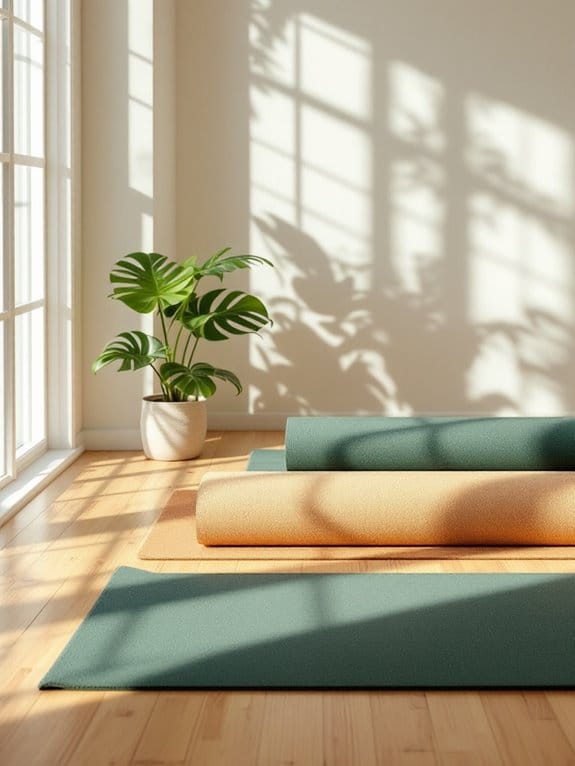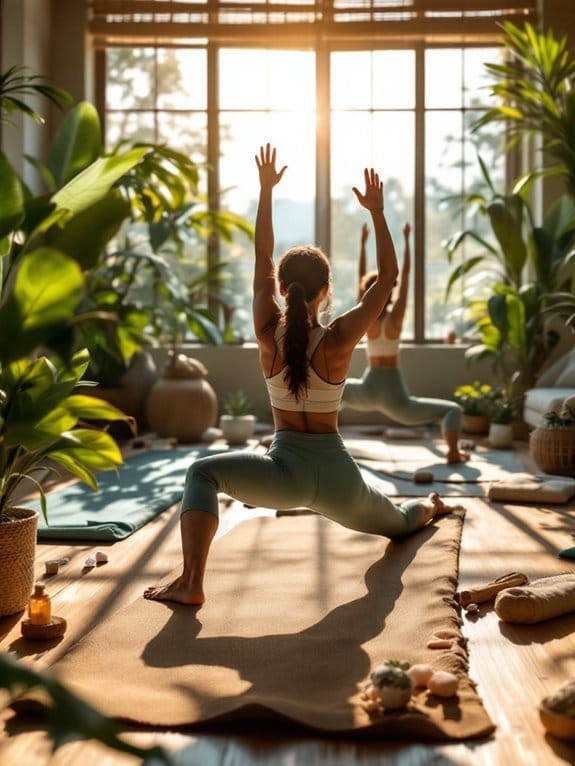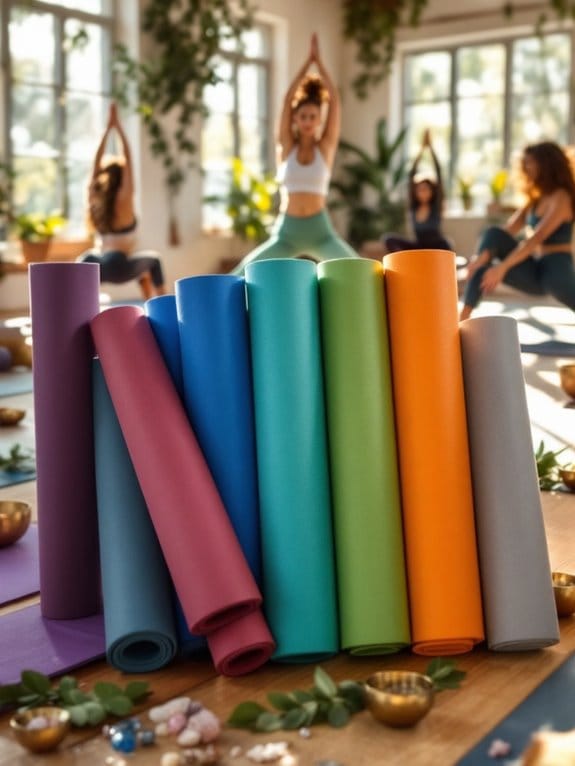For sustainable yoga practice in 2025, you'll find excellent options in three top eco-friendly mats. The Gaiam Cork Yoga Mat offers superior wet-grip and plush 5mm cushioning, while the Gruper TPE Mat features a versatile double-sided texture with multiple size choices. The Premium Cork Mat includes helpful alignment lines and a natural rubber base for ideal stability. Each mat emphasizes sustainability through non-toxic materials and durable construction. Let's explore how these mindful choices can enhance your practice.
Key Takeaways
- Gaiam Cork Yoga Mat leads eco-friendly options with superior moisture-activated grip and sustainable cork-TPE construction for mindful practice.
- Premium Cork Yoga Mat features alignment lines and natural rubber base, offering optimal support for proper form during practice.
- Gruper Yoga Mat provides eco-conscious practitioners multiple size options with non-toxic TPE material and double-sided grip texture.
- All three mats are 5mm thick, providing essential cushioning while maintaining stability and connection to the ground.
- These mats' sustainable materials, including cork, TPE, and natural rubber, minimize environmental impact while lasting 3-4 years with proper care.
Gaiam Cork Yoga Exercise Mat for Hot Yoga & Pilates
- CORK YOGA MAT: Crafted with natural cork top and eco-friendly TPE bottom for a premium, sustainable yoga and exercise experience, ensuring stability and comfort in your...
- SWEAT and ODOR-RESISTANT CORK: Moisture-proof and odor-free, our natural cork material ensures a clean, fresh Yoga Workout surface, blocking dirt and unpleasant odors for...
- HOT YOGA MAT: A must-have for all types of yoga, but especially heated and hot yoga classes, as temperatures rise and the cork begins to loosen it will become softer and...
Athletes seeking an eco-conscious yoga mat will find their match in the Gaiam Cork Exercise Mat. You'll love the sustainable blend of natural cork top and TPE bottom, measuring 68 x 24 inches with 5mm thickness.
Your practice gets better as you sweat – the cork surface actually improves its grip when moisture hits it. At just 1.71 pounds, you won't strain carrying it to class. The plush cushioning protects your joints during everything from gentle stretches to intense hot yoga sessions.
You'll notice it might curl at first, but don't worry – just weigh down the corners. A quick hand wash keeps it fresh, while the natural cork scent and sweat-resistant surface guarantee your mat stays clean through countless flows.
Best For: Eco-conscious yogis and hot yoga enthusiasts who want excellent grip that improves with moisture while maintaining a sustainable practice.
Pros:
- Natural cork surface provides superior grip that actually improves when wet
- Eco-friendly materials with natural cork top and TPE bottom
- Thick 5mm cushioning offers excellent joint support and comfort
Cons:
- Initial curling issues require weighing down corners
- Hand wash only, which may be inconvenient for some users
- Higher price point compared to standard yoga mats
Yoga Mat Non Slip with Carrying Strap for Exercise & Pilates
- NEW ECO FRIENDLY MATERIAL: The upgraded Gruper Yoga mat is made with premium friendly material. It costs more to make, but it is safer and more soft than traditional...
- UPGRADED ANTI-SKID DESIGN AND DOUBLE LAYER ANTI TEAR: Special sticky non slip texture on both sides , more Hard-wearing than regular yoga mats and resistant to tearing...
- TWO DIFFERENT SIZE OTPTIONAL : ①☛ Standard Size:72"(183cm) x 24" (61cm); Thickness: 0.24"(6mm); Weight: 2.6lb. ②☛ Thickened Size:72"(183cm) x 24" (61cm);...
Exercise enthusiasts seeking an eco-conscious workout solution will find their match in the Gruper Yoga Mat. You'll appreciate the non-toxic TPE material that's both odorless and environmentally friendly. The mat's double-sided texture provides superior grip while its dual-layer construction prevents tearing.
You've got three size options to choose from, including a standard 72" x 24" with 6mm thickness or larger versions up to 32" wide. The moisture-resistant surface works perfectly for hot yoga, and you won't need to worry about slipping during intense poses. Just remember to avoid wearing shoes and keep it out of direct sunlight to maintain its quality.
Best For: Yoga and fitness enthusiasts who prioritize eco-friendly products and need a durable, non-slip mat for various exercise routines including hot yoga and Pilates.
Pros:
- Superior grip with double-sided non-slip texture for safe practice
- Eco-friendly TPE material that's non-toxic and odorless
- Available in multiple sizes and thicknesses to accommodate different needs
Cons:
- Carrying bag quality doesn't match the mat's premium standards
- Storage can be challenging due to mat's tendency to unroll
- Higher price point compared to traditional PVC yoga mats
Premium Yoga Cork Mat with Natural Rubber Base (5mm Thick)
- Sustainable and Eco-Friendly: Our yoga mat is made from high-quality cork, a renewable and biodegradable material, making it an eco-conscious choice for your yoga...
- Superior Grip and Traction: The natural cork surface provides excellent traction and grip, ensuring a stable foundation for your poses and preventing slips or sliding...
- Versatile and Multipurpose: Our yoga cork mat can be used for a wide range of yoga exercises, whether you're a beginner or an experienced yogi, our cork mat is suitable...
Whether you're an eco-conscious yogi or seeking superior grip, this Premium Cork Yoga Mat delivers exceptional performance. You'll appreciate the 5mm natural rubber base that provides stability during challenging poses. The cork surface offers excellent traction that actually improves when you sweat.
You'll find the alignment lines especially helpful for maintaining proper form in your practice. The mat's eco-friendly materials – renewable cork and natural rubber – make it a sustainable choice. At 4.7 stars from 169 ratings, other yogis love it too. While it's slightly heavier than synthetic mats, you'll get superior grip and durability that's worth the extra weight.
Best For: Eco-conscious yoga practitioners seeking superior grip and stability who want alignment guidance and don't mind a slightly heavier mat.
Pros:
- Excellent grip that improves with moisture, making it ideal for hot yoga and intense practices
- Made from sustainable materials (cork and natural rubber) with zero toxic components
- Built-in alignment lines help maintain proper form during poses
Cons:
- Heavier than traditional synthetic yoga mats
- Higher price point compared to standard yoga mats
- May require occasional re-wetting during practice to maintain optimal grip
Factors to Consider When Choosing Eco-Friendly Yoga Mats

When you're ready to invest in an eco-friendly yoga mat, you'll want to carefully examine five key factors that determine its sustainability and performance. You'll need to look at the mat's materials and where they come from, how long it'll last, its environmental footprint throughout its lifecycle, grip performance, and maintenance needs. Understanding these essential elements will help you choose a mat that's both kind to the planet and perfect for your practice.
Material Composition and Sourcing
Understanding the material composition of eco-friendly yoga mats can make a significant difference in your practice and environmental impact. You'll find three main sustainable materials dominating the market: cork, TPE, and natural rubber.
Cork stands out for hot yoga enthusiasts because it's naturally sweat-resistant and provides better grip as you perspire. If you're sensitive to odors, you'll appreciate TPE's odorless nature and non-toxic properties. The integrated foaming technology in TPE mats gives you extra cushioning for joint support.
When you're examining natural rubber options, pay attention to the thickness measurements. You'll typically find these mats in 5mm versions, which offer ideal support for most yoga styles. Remember that each material's sourcing affects both durability and environmental footprint, so you're making an impact beyond your practice.
Durability and Longevity Features
Since durability directly impacts your mat's performance and environmental footprint, choosing the right eco-friendly yoga mat requires careful consideration of longevity features. You'll find that cork and natural rubber mats, typically 5mm thick, offer superior support and lasting performance during your practice.
Look for mats with double-layer construction or integrated foaming technology, as these features help prevent tearing and maintain shape over time. TPE and cork materials resist wear better than traditional PVC, so you won't need to replace your mat as frequently. To maximize your mat's lifespan, you'll want to clean it regularly with a damp cloth and store it away from direct sunlight. These simple maintenance steps, combined with high-quality eco-materials, guarantee your sustainable mat will remain a reliable companion through countless yoga sessions.
Environmental Impact Assessment
Making informed choices about eco-friendly yoga mats requires a thorough assessment of their environmental impact. You'll want to examine the mat's entire lifecycle, from production to disposal, to understand its ecological footprint.
When evaluating materials, look for mats made from sustainable sources like cork, TPE, or natural rubber. These materials don't rely on petroleum-based manufacturing processes, which helps reduce carbon emissions. You'll also benefit from fewer toxic chemicals in your practice space.
Consider the mat's longevity, as durability directly impacts waste reduction. A high-quality eco-friendly mat that lasts 3-4 years creates less environmental burden than replacing cheaper mats annually. Check if your mat's recyclable or biodegradable – this guarantees it won't sit in landfills for decades like traditional PVC mats.
Grip and Performance Quality
When choosing an eco-friendly yoga mat, grip and performance quality should be your top priorities for safe practice. You'll notice that eco-friendly mats actually improve their grip when you're sweating, making them perfect for hot yoga sessions.
Cork mats are your best bet for stability – they'll keep you firmly planted during challenging poses. If you're looking for comfort without sacrificing grip, choose a mat that's around 5mm thick. You'll get the cushioning you need while maintaining solid contact with the ground.
Natural rubber and TPE mats won't just keep you stable; they'll also provide an odor-free experience that won't distract from your practice. Thanks to their double-layer construction, these mats won't tear or deform, so you'll maintain consistent performance throughout your yoga journey.
Care and Cleaning Requirements
The proper care of eco-friendly yoga mats starts with three essential cleaning practices. After each session, you'll want to wipe down your mat with a damp cloth to remove sweat and debris. For deeper cleaning, use mild soap and water to hand wash your mat thoroughly. Finally, let your mat air dry away from direct sunlight to prevent material degradation.
If you've just unrolled a new mat that's curling at the edges, don't worry – it's normal. You can speed up the flattening process by placing weights at the corners overnight. Remember that your eco-friendly mat needs gentle treatment, so avoid machine washing or harsh cleaning products. Most TPE and cork mats resist moisture and odors naturally, but they'll still benefit from regular maintenance to extend their lifespan.
Frequently Asked Questions
How Often Should I Clean My Eco-Friendly Yoga Mat?
You should clean your eco-friendly yoga mat after every session with a quick wipe-down using a natural mat cleaner. For deeper cleaning, aim to thoroughly wash your mat once a week if you practice daily, or every 2-3 weeks for occasional use. Don't forget to spot clean any visible dirt or sweat marks immediately. Proper cleaning extends your mat's life and keeps your practice hygienic, but always follow the manufacturer's specific care instructions.
Can I Leave My Cork Yoga Mat in Direct Sunlight?
It's best to avoid leaving your cork yoga mat in direct sunlight. While cork is naturally antimicrobial and durable, prolonged sun exposure can dry out the material and cause warping. You'll want to store your mat in a cool, dry place away from windows and heat sources. If you need to dry your mat after cleaning, opt for indirect light or shade. This will help maintain your mat's texture and extend its lifespan.
What's the Average Lifespan of an Eco-Friendly Yoga Mat?
Like a faithful companion on your wellness journey, an eco-friendly yoga mat's lifespan varies by material and care. You'll typically get 2-3 years from natural rubber mats with regular use, while cork mats can last 3-4 years. Your mat's longevity depends heavily on how you maintain it. With proper care (weekly cleaning, avoiding direct sunlight), jute and cotton mats can serve you well for 2-3 years. TPE mats often stretch to 4-5 years.
Are Eco-Friendly Yoga Mats Safe for People With Latex Allergies?
If you have a latex allergy, you'll need to carefully check the materials in eco-friendly yoga mats. Many natural rubber mats contain latex proteins that could trigger reactions. Instead, look for mats made from TPE (thermoplastic elastomer), cork, or jute – these materials are latex-free. You'll find plenty of safe options from brands like JadeYoga's latex-free line or Manduka's eKO series. Always double-check product labels and contact manufacturers directly if you're unsure.
Can I Use Regular Mat Cleaner on Natural Rubber Yoga Mats?
Don't let your yoga mat cleaning routine become a slippery slope! Regular mat cleaners often contain harsh chemicals that can break down natural rubber over time. You'll want to stick with gentle, pH-neutral cleaners specifically designed for rubber mats. You can also make your own solution using a 1:4 ratio of white vinegar to water. Add 2-3 drops of tea tree oil for extra antimicrobial power without damaging your mat's surface.








